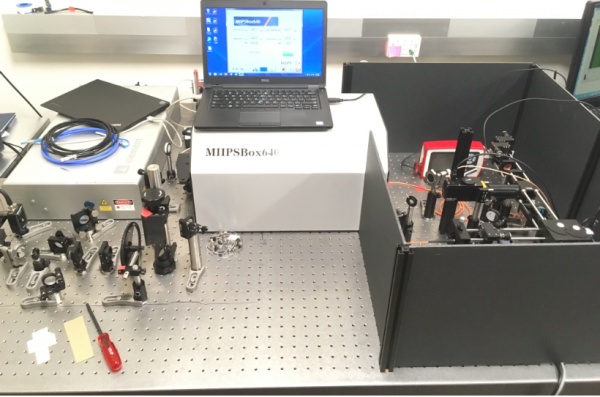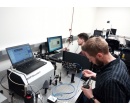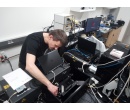Lab visit to the University of California Irvine
J. Bogusławski, P. Ciąćka and Ł. Kornaszewski, members of prof. Wojtkowski's group spent three weeks at the University of California Irvine on a research visit to Palczewski Lab (part of the Center of Translational Vision Research). The aim of the visit was to build a custom two-photon-excited-fluorescence scanning light ophthalmoscope (SLO) for murine eyes. Before Palczewski Lab was moved to UC Irvine, a prototype of such a device had been built by the Wojtkowski team at Case Western Reserve University in Cleveland based on a 1-um femtosecond laser. This time J. Bogusławski, P. Ciąćka and Ł. Kornaszewski successfully delivered a working device in close-to-final configuration employing a 740 nm laser source.
Besides the actual construction of the setup starting from the empty table, another goal of the stay was aimed at rigorous measurements of group-velocity dispersion in the setup. A crucial issue for two-photon fluorescence excitation, delivering the shortest possible pulses to the sample requires compensation of dispersion of various optical components in the setup. The data collected was used to validate computations and will serve as a guide in constructing a dedicated cost-effective pulse compression solution.
Moreover, the lab visit was aimed at testing the correct operation of the setup and characterization of its performance. Researchers checked the setup in terms of non-linear fluorescence response vs average power, obtaining quadratic scaling expected for a two-photon process. Various fluorescent samples, including murine retina preparations, were imaged with their setup. An important point was benchmarking the device against another two-photon SLO available in the lab. That setup, based on the commercial Leica microscope, has by its nature several drawbacks that their dedicated system aims to overcome. On the other hand, for the dedicated set up to be a worthwhile replacement for Leica, its performance has to match or exceed the latter in sensitivity, signal to noise ratio, and image quality. Benchmarking the limits of sensitivity in both setups performed during the visit using standardized samples, matched imaging systems, and similar excitation laser sources should inform the future choice of an optimal detection scheme for our setup.
Visitors
Jakub Bogusławski, Piotr Ciąćka, Łukasz Kornaszewski
Dates
Feb.9 – Mar. 3, 2019
Location
The University of California Irvine, Irvine, CA, USA





